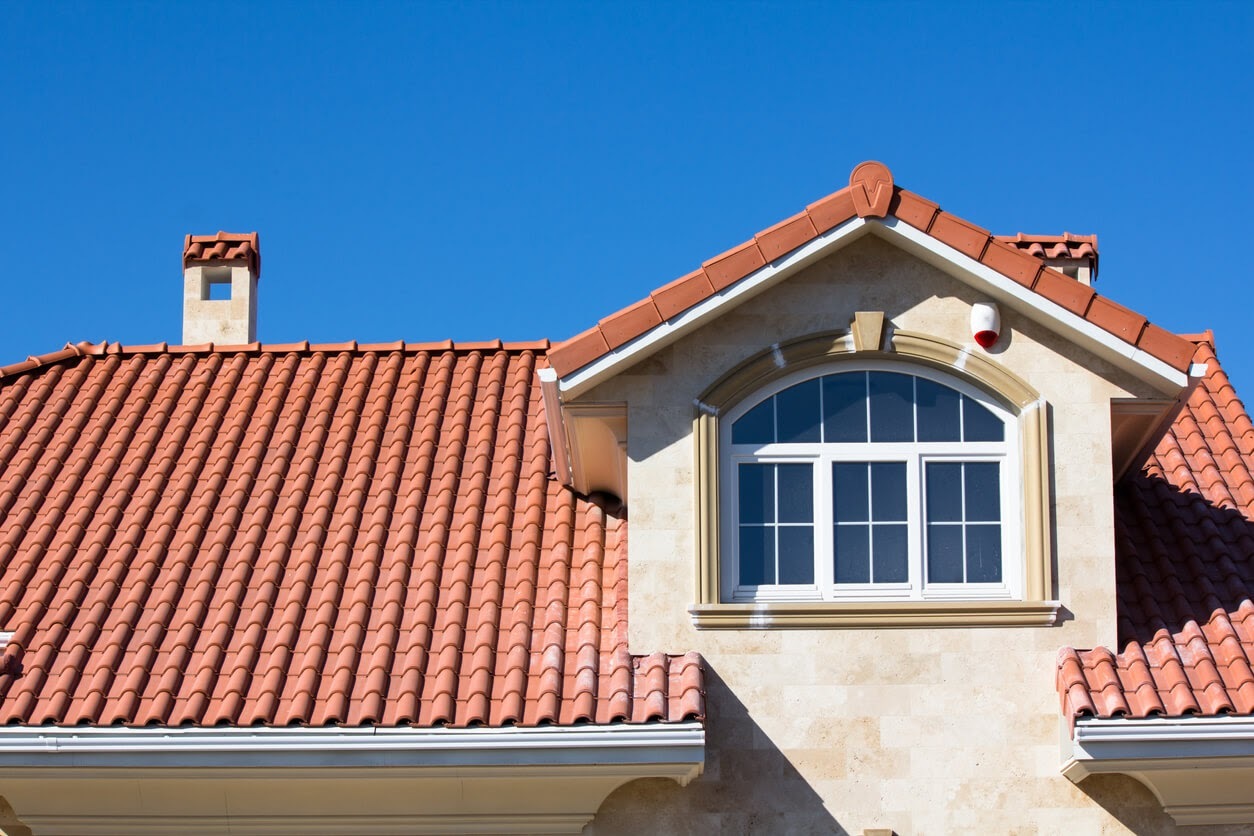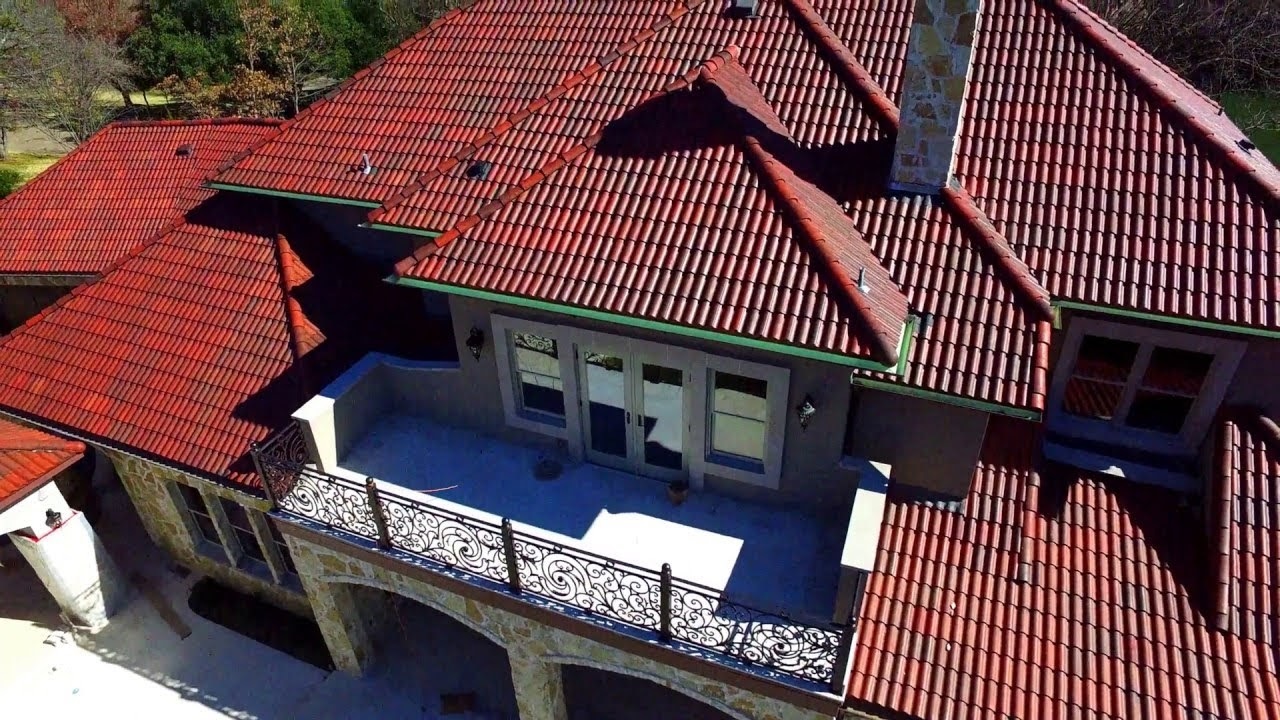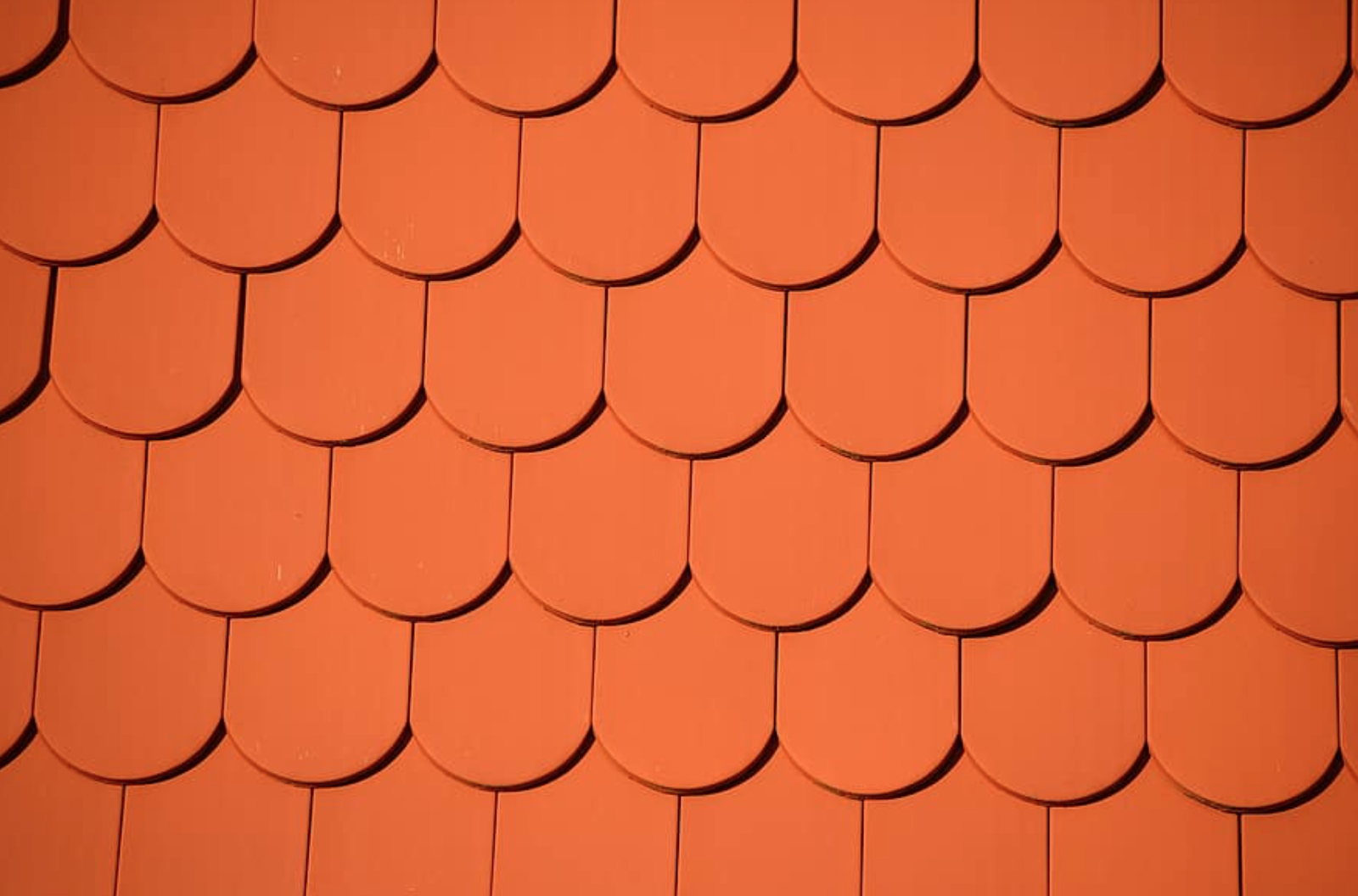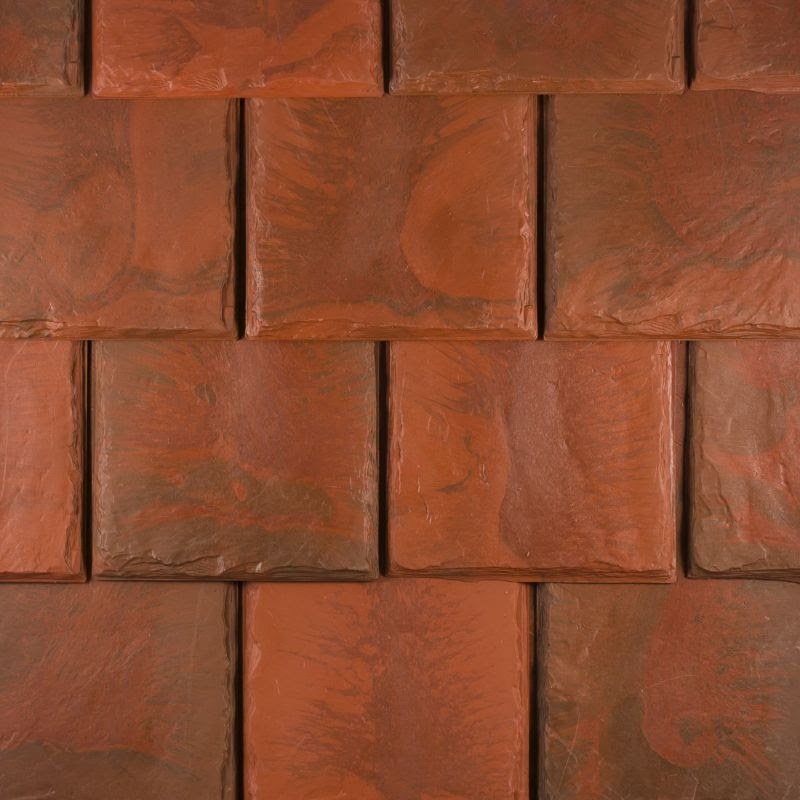Brava red synthetic roofing tiles provide a colorfast, tremendously durable, less fragile, easier to install, low-maintenance alternative to red clay, red slate, and red concrete roofing tiles.
Red tile roofs give residential, commercial, and historical properties a stately, old-world look. They will also last many years when correctly and professionally installed and maintained. Tile roofing systems consist of overlapping roof tiles that are secured to a roof deck or solid substrate on a sloped roof.
Red tile roofing comes in several common materials, including clay, slate, concrete, and synthetic, and most of these materials offer various shapes and sizes. Selecting tile often comes down to aesthetics, although other vital factors should also play into the decision, such as roof pitch, durability, weather resistance, longevity, and maintenance, along with the weight of the tile, ease of installation, and cost.

Selecting the Best Red Roof Tiles
The best red roof tiles for your home or building need to reflect the architectural style and roof pitch. Not to mention, finding the best red roof tiles also means selecting a tile that matches the local climate and your affordability. If you're interested in exploring red roof tiles, try out our visualizer to help you determine the best red roof tile for you. You can also explore or video and photo galleries to explore as well.
Is the Tile Acceptable for the Roof Pitch?
The pitch of your roof plays a vital role in determining the best roofing material for your home or building. Due to drainage issues, tile roofs need at least a 2:12 slope. Roof slopes between 2:12 and 4:12 need a double layer of Type II asphalt felt or Class M mineral-surfaced roll roofing underlayment. Slopes of 4:12 and steeper need only one layer of underlayment, overlapping a minimum of 2 inches. Avoid using tiles on roof slopes above 19:12 because tiles tend to rattle on steep roofs.
Red Clay Tile

For hundreds of years, clay tile makers have used terracotta to make terracotta-clay tiles that have a well-known distinct red color. The unique style, color, and durability of terracotta-clay tiles adds a refined, old-world elegance to a home or building. They can also enhance curb appeal and can meet many design goals for both residential and commercial use. However, several issues can diminish the appeal of terracotta clay tiles. They are high-maintenance and can crack if stepped on or hit by a flying branch. They also lack moisture and cold-temperature resistance and will require underlayment replacement after 20-years. Inadequate flashing or lapping of the clay tiles can diminish a roof's integrity, leading to leaks in the roofing.
How Are Red-Clay Tiles Made?
Today's manufacturers typically extract the clay from a nearby quarry, press it into molds, then fire at high temperatures. An application of a chemical glaze (silica, manganese, fluxes, and aluminum oxide) further enhances the terracotta color. It also increases the tile's resistance to freezing and excessive heat.
The Pros and Cons of Red Roofing Tiles
Pros of Red Clay Tiles
Durable
Clay tile is durable against weathering, with an expected lifespan of 100 years. Properly installed red clay tiles resist impact, wind, fire, and rot.
Wind-Resistant
The heavyweight and layered structure creates optimal wind resistance, protecting your home or building from wind speeds up to 150 mph.
Fire-Resistant
The stone-like characteristics of clay tiles make them fire-resistant (the highest fire level rating — Class A), protecting a home or building from falling embers and ashes. Notably.
Rot-Resistant
Clay tile will not rot and resist damaging insects. However, to stop insects like wasps from making nests between the clay tiles' gaps, apply cement filler to the gaps.
Sustainable
Manufacturers use the Earth's natural materials to make recyclable and eco-friendly clay tiles. It is important to know that the production of clay tiles doesn't release toxic chemicals into the air.
Energy-Efficient
Clay tile roofs provide thermal properties, lessening heat loss or gain. The tile layering encourages natural air ventilation and good air-flow, creating a heat transfer barrier, keeping your roof warm in the winter and cool in the summer— reducing energy costs by as much as 20%.
Long-Lasting Color
The distinct red color of terracotta clay does not fade with time, but simply improves with age.
The Cons of Terracotta Clay Tiles
Weight
Red clay tiles weigh between 600 - 1,500 pounds per square, making it one of the heaviest roofing tiles sold, often requiring home and building owners to add extra reinforcement to the roof framing, particularly in regions prone to significant snow accumulation. The cost to reinforce a tile roof ranges between $1,000 and $10,000.
The High Cost
Clay roof tiles are one of the most expensive roofing products on the market compared to asphalt, wood, and metal tiles. A red clay tile roof ranges between $800 - $1,800 per square for the material.
Fragile
Fragile clay tiles can easily break and crack during installation from foot traffic and falling debris - compromising the roof's integrity and leading to structural and roofing damage. For the longevity and integrity of a clay roof, you must conduct regular inspections for damage, then immediately replace or repair any broken or cracked tiles.
Replacing the Underlayment
Red clay roofing tiles can last up to100 years; however, the underlayment lasts only 20 years. The cost to replace the underlayment of a 1,500 sq. foot tile roof can range between $5,400 to $7,660, including labor. Time-consuming, tedious, and expensive underlayment replacement involves removing the clay tiles, replacing the underlayment, and then reinstalling the tiles.
Water Permeability
Clay tiles are water-shedding systems, meaning they will let some water through from melting snow and windblown rain. Therefore, clay tile roofs must include a waterproofing membrane.
Climate Limitations
Red clay tiles may crack or break during rapid freezing and melting, and therefore, they are not a good choice for cold climates.
Red Slate Tiles

As a natural stone, eco-friendly slate creates aesthetically pleasing and durable roofing tiles, resisting harsh ultraviolet rays, excessive heat, and freezing temperatures, potentially lasting more than 150 years. The slate's color depends on the rock's mineral composition — the red slate's hue comes from hematite, a crystalline form of ferric oxide. The natural beauty of slate has topped homes and buildings for over 200 years. However, the heavy weight and complicated installation process make labor costs for slate roofing expensive. Slate roofing costs $500 to $1,700 per square, depending on the durability, color, and thickness. The overall high price reflects the dangers and difficulties in mining the stone and the labor-intensive requirements to manufacture the slabs into shingles. Additional problems include the fragility of slate tile, making it prone to breaks and cracks and leading to costly maintenance and repairs. The integrity and performance of slate tile depend on proper installation by a qualified contractor specializing in slate roofing.
Pros of Red Slate Tile Roofing
Construction
Properly constructed, slate roofs can last 150 years.
Variety
Beautiful and elegant slate roofs come in various sizes, thicknesses, and colors, including red.
Fire-Resistant
Fire-resistant slate roofing can prevent fires caused by airborne sparks from wildfires or adjacent structure fires.
Eco-Friendly
Environmentally-friendly, long-lasting slate tiles reduce waste in landfills, unlike other roofing products like asphalt shingles.
Cons of Red-Slate-Tile Roofing
Color Fading
Over time, weathering will cause the tiles to change to grey, brown, or rust. Permanent shades do not fade but cost up to 25 percent more.
Fragile
Natural slate tiles come in two types, soft and hard. The less expensive soft slate tiles will cost you more over time for repair and replacement than the more durable hard tiles. The fragility of slate tile makes it susceptible to cracking or breaking during, and after, installation, particularly if walked on. A cracked tile can lead to moisture damage to the roof and structure. Furthermore, you may find it difficult to replace a natural slate roof tile with a perfect match because of the unique color.
Expensive Installation Costs
The weight of the tile and the need for an expert slate roofing contractor make it more expensive than most other roofing materials—labor installation costs of a slate roof range from $900 to $1,600 per roofing square.
Heavy Weight
Slate tiles weigh 1,500 to 3,000 pounds per square, making them challenging to handle. Furthermore, the weight of the slate often requires extra structural support be added to the building or home.
Red Concrete Tile
The first introduction of concrete tiles in the U.S. occurred in the early 1900s, but they didn’t become popular until the 1960s —today, they account for more than half the tiles sold in the U.S.
How to Make Red Concrete Tiles
Red concrete roofing tiles are produced with a mixture of sand, cement, and water, and molded under heat and high pressure. A paint-like material applied to the exposed surface of the tiles adds the red color. Water locks or interlocking ribs at the edges of the concrete tiles prevent water infiltration. Typically, concrete tiles come in three styles, simulating traditional clay, slate, and stone tiles. When properly installed, concrete tiles resist hail, wind, and fire, making them a durable material. Moreover, concrete roofing tiles weigh less than clay tiles, making installation easier, safer, and less expensive.

A concrete tile roof requires professional installation, moisture-resistant measures, and a sufficiently reinforced roof framing system. Concrete tile roofs require regular and costly maintenance due to impact and water damage, color fading, and the underlayment's routine replacement. Without these precautions, the integrity of the roof tiles and the house or building can become compromised.
Pros of Red Concrete Tile Roofing
Durability
Durable concrete roof tiles, with a lifespan of 50 years, maintain their integrity and won't break or crack when exposed to destructive pests, hail, freezing temperatures, 125-mile winds, and fires.
Relatively Lower Cost
Concrete tile roofs cost about $150 to $250 per square.
Cons of Red Concrete Tile Roofing
Color Fading
A red concrete tile will fade over time, making matching replacement tiles difficult. The porous nature also makes it susceptible to staining. Therefore, you must repaint a concrete tile roof every few years to keep it looking new.
Heavy
Concrete roof tiles weigh 600 -1100 pounds per square, requiring homeowners to add extra roof frame reinforcement, particularly in regions that experience heavy snow.
Roof Maintenance
Concrete roof tiles require routine maintenance and repairs to preserve both their appearance and integrity. Moss and mildew can grow between concrete tiles, especially in wet climates, requiring the roof to need annual power washing. Limiting long-term damage to a concrete tile roof requires regular inspection and timely repairs, particularly after a severe weather event.
Water Damage
Concrete tiles not treated and waterproofed will absorb water at a rate of 13% through air moisture, rain, and even foliage. Water absorption leads to mold and mildew, potentially deteriorating tiles. Furthermore, the water's added weight on the tiles puts more pressure on the home or building, and can lead to significant structural issues.
Impact Damage
Impact damage to concrete tiles can occur for many reasons: a tree falling on a roof, foot traffic, and improper installation. For example, chips and cracks at the lower right corner of a tile can occur from the tiles' spacing in a way that restricts their ability to expand. Homeowners must immediately repair or replace the damaged tiles to avoid harming the house's underlayment and interior.
Replacing Underlayment
Concrete roofing tiles may last up to 50 years; however, the underlayment requires replacement after 20 years. The cost to replace the underlayment of a 1,500 sq. ft. concrete tile roof ranges between $5,400 to $7,660, including labor.
Dark Red Synthetic Tiles

Synthetic slate roofing looks like authentic slate, clay, and even wood roofing, except it's composed of recycled plastic and rubber materials. Manufacturers of synthetic slate roofing offer a wide variety of shapes to fit any architectural style.
Pros of Dark Red Synthetic Roof Tiles
Available in Many Shapes and Styles
Synthetic roof tiles come in many styles shapes to mimic stone slate, wood shakes, and clay tile, accommodating any home or building owner's architectural style.
Priced Lower than Natural Stone Tiles
Synthetic roofing tiles cost about $165 to $509 per square, much less than either clay or slate.
Impact-Resistant
Synthetic roofing tiles achieve a Class 4 impact rating, standing up to wind, hail, ice rain, and debris, protecting the home's or building's structure and interior, and saving on expensive repairs and possible roof replacement. Impact-resistant shingles offer several specific features that contribute towards a long-lasting, low-maintenance roof. Impact-resistant shingles help ensure that a roof will maintain its integrity and strength against flying debris, winds, and hail up to 110 mph.Furthermore, most impact-resistant shingles, like Brava synthetic slate roofing, have a Class A fire rating.
Durability
Synthetic roof tiles resist freeze and thaw cycles.
Lifespan
Red synthetic roof tiles have a long lifespan of 50 years.
Flexible
Synthetic tiles allow you to walk on them without fear of breaking.
Low Weight
Synthetic roofing tiles weigh 200 to 400 lbs per square, significantly less than the weight of slate, clay, or concrete tiles. Therefore, synthetic red roof tiles do not require substructure modifications. Eco-FriendlyManufacturers use recycled products to make synthetic tiles, helping to reduce landfill waste.
Maintenance and Repairs
Synthetic shingles require little to no maintenance. However, you will find repairing synthetic tiles relatively simple compared to natural stone tiles.
Choosing the Right Size and Shape Tile for Your Red Roof
Along with selecting the best material, you also must select the right size and shape for your red roof tiles.
Selecting the Right Size — Plain vs. Interlocking Tiles
Selecting between plain tiles and the larger interlocking roof tiles depends on your aesthetic preferences and budget.
Plain Tiles
The simple rectangular shape of plain roof tiles, typically smaller but heavier than interlocking tiles, creates an attractive and traditional appearance. Installers must double-lap when laying the tiles to ensure weather tightness. Flat-overlapping clay tiles stagger joints in overlapping courses like shingles or slates.
Interlocking Tiles
Interlocking roof tiles have a unique shape that allows them to fit together tightly and securely. Interlocking tiles still require fixing to the roofing battens, but their design requires only a single lap. Furthermore, the larger interlocking tiles' size means fewer tiles to cover the roof than plain tiles, making installation of interlocking tiles quicker and more cost-effective than plain tiles. Interlocking tiles have an extrusion or lip on one tile that hooks over an edge or channel on an adjacent tile.
Five Tile Shapes for Your Roof
Choosing the right tile shape for your roof depends on the architectural style of your home or building.
1. Flat Red Tiles
Flat-roof tiles lack in barrels or rolls, offering a crisp, clean appearance that perfectly complements traditional and modern architecture.
2. Spanish Red Tile

Spanish roof tiles offer a simple, one-piece barrel design, providing a pattern of distinctive ripples (S-shape) across the surface of a roof. S-shape tiles combine the top cap and the bottom pan pieces and come in one-piece or two-piece styles. A Spanish roof tile can enhance any architecture, and you will find them most commonly on Mediterranean or Spanish style homes and buildings.
3. Mission Red Tile
With high profile barrels, mission roof tiles create distinctive shadows that can change the roof's feel and look as the Sun travels across the sky — adding significant texture and style to the home or building's exterior. Mission roof tiles pair well with Italian, Southwestern Mission, and Spanish architecture. For a formal look, lay the tiles in straight rows. To produce a more rustic look, stagger the tiles.
4. French Red Tiles

French roof tiles (sometimes called Marseille tiles) have a low profile and robust interlocking design, with two flutes on the tile's surface. French Red Roof tiles go well on a French Provincial chateau, offering country-chic charm.
5. Scalloped Red Tiles

Scalloped roof tiles create a unique look with their curved bottom edge, giving the roof a fish scale appearance, pairing well with arts and crafts, and cottage-style homes.
Why Choose Brava Red Synthetic Roofing Tiles?
Brava red synthetic roofing tiles are the best red roof tiles over clay, slate, or concrete materials. Brava’s revolutionary multi-coloring process creates a non-fading, classic red roof with authentic color variation and flow (in any custom color or combination) throughout the entire tile, from light red to a dark red roof tile. Red slate and red concrete tiles both fade over time, losing some of their beauty. Lightweight Brava synthetic roofing tiles install easily and quickly, without all the installation problems of clay, concrete, asphalt and slate. Installation of synthetic tiles involves workers simply cutting the synthetic slate shingles with a utility knife, and using a pneumatic nail gun and standard roofing nails to nail the shingles in place. Lightweight Brava products reduce shipping costs and lessen installation expenses by eliminating the need for extra structural support, and reducing labor costs. Brava roofing tiles have a 50-year limited warranty, have undergone extensive testing, and have received certifications for the highest wind, fire, and hail levels. Moreover, impact-resistant and flexible Brava synthetic roof tiles allow, without damage, foot traffic, during and after installation, unlike clay, slate, and concrete tiles. Eco-friendly Brava roofing tiles are made of recycled and recyclable material. The manufacturing of Brava products also saves energy over that required to mine slate, extract clay, or harvest trees.
Brava Barrel Tile - Composite Spanish Roof Tile

Brava’s composite Spanish roofing tiles are the perfect alternative to barrel red clay tile. Along with its aesthetic value, our product features several significant benefits. Brava barrel tile stands out as the only composite Spanish tile on the market that is third-party tested, and Miami-Dade County approved. Environmentally friendly Brava Spanish Class C is also the only white composite tile on the market.
Brava Old World Slate - Synthetic Slate Tile

Brava's lightweight composite-red-slate tile offers the incredible beauty of natural slate roofing without the costly substructure modifications. It also lessens time and costs for maintenance and repairs - unlike fragile and high-maintenance natural slate.
A Better Alternative to Red-Painted Concrete Tiles
Unlike concrete tiles, lightweight Brava Roof Tiles protect against color fading, moisture, impact, and structural damage. These protections also help shield the underlayment, which reduces its need for replacement, though we do offer an underlayment with a 50-year warranty.
Finding the Best Red Roof Tiles with Brava
Selecting tiles for your roof is important, but selecting the best red roof tiles starts with Brava. In addition to providing samples of products and quotes, we help you find a contractor. (Just check out our 2022 Brava Excellence Awards to learn more.)
For more information on why you should choose synthetic red roof tiles over clay, slate, or concrete, please contact us at Brava Roof Tile.
And for more homeowner information, please visit the links below:



